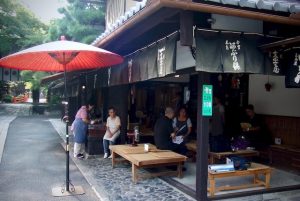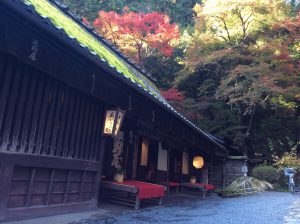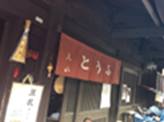Gravity(Attraction) of Kyoto 12 Intangible assets of long-established companies 1
Yoshie Doi
 |
 |
 |
Aburi mochi ichiwa Hiranoya Iriyama-tofu
In Kyoto, there are the long-established Ikenobo Flower Arrangement Society, which was founded in 587, Genda Paper, which was founded in 771, Tanaka Iga Buddhist Supplies, which was founded in 885, and, Aburi mochi ichiwa shop founded in 1000.
The Ikenobo Ikebana Society, founded in the Asuka period, coincided with the introduction of Buddhism, and the practice of offering flowers to Buddha became commonplace. The Heian period Choju Jinbutsu Giga paintings, which depict Buddhist flowers and prayer beads, made me smile. Rabbits and frogs hold prayer beads. Also, during memorial services, monkey monks offer flowers with prayer beads in their hands. The fact that the same scenes are still being performed by human hands today makes you realize how long history has passed.
President Genda of Genda Paper gave a lecture on Mizuhiki at the Kyo- Suzume School’s ” Kyoto Wood spirit Tales” event. Mr. Kenichi Hasegawa, head of Aburimochi Ichiwa, has been working hard as a representative of the Okudosan Mirai-shu. Ichiwa’s Aburimochi has been made almost exactly the same way since the company was founded, and the same tea shop that manufactures and sells Aburimochi has been in operation in the same place for 1,025 years. The mochi is coated with soybean flour and then roasted. It has been the same method for a thousand years. We have held two lectures at the Kyo-Suzume School and also hosted the Okudosan Summit. It is the oldest surviving tea shop (cafe) in the world.
Hiranoya, located next to the first torii gate of Atago Shrine, has been cooking rice in an okudosan for 400 years. They actually light a fire using wood and straw and take great care in cooking the rice. Iriyama Tofu Shop has been cooking soybeans in an okudosan for 200 years. Today we use gas. Why do they continue to cook soybeans in an okudosan in this age of electricity? It’s because they’re delicious. Rather than convenience, the rice, tofu, and red beans are delicious, made with great care. We’ll discuss this in the next chapter, but we’ll understand if we compare the different flavors. The aroma and the way they’re cooked are different.
Recently, I have come to realize that the traditional value of the Okudosan is packed with value that can act as a bridge to a paradigm shift. It is not just convenience that is valuable, but the five human senses, the crackling sound of the fire, the smell, and the flickering of the fire, all of which stimulate my brain waves.
The depth of Kyoto culture is also surprising. In Kyoto, fire is important. At the Okera Mairi ceremony at Yasaka Shrine, where fire is received to welcome the new year, the Okera fire is transferred from the Okera lantern to an auspicious rope, which is then carried home to ensure the fire does not go out. There is a custom of welcoming the new year with new fire and water. It was common to make zoni using fresh water drawn from a well.
In Kyoto, where the Imperial Palace is located, for many years the water for the first bath of children born in the Imperial family was boiled over the fire in Kawabata Doki’s oven. The fire for the first bath of Emperor Meiji was also boiled over the fire in Kawabata Doki’s oven, which was used to boil the well water at the Nakayama residence. Among the items that Kawabata Doki presented to the Imperial Court were ashes.
When Emperor Ninko passed away, a total of 53 bales of ashes were placed there. In order to maintain the purity of the fire, Kawabata Doki would not burn anything other than firewood or brushwood, such as scraps of paper, in the hearth. This custom continued until the Meiji Restoration.
I am amazed at the depth of Kyoto culture, which was so considerate of the invisible sacredness of fire. I believe that by uncovering this depth, we can become a bridge for a paradigm shift that will lead to new values.
Looking at European history, the Austrian restaurant Stiftskeller St. Peter was founded in 803, the Paris Mint in 864, and the Royal Mint in the UK in 886, both in the 1800s. Restaurants, which are essential for survival, are indeed some of the oldest in the world.
There are 50 companies in the world that were founded before 1300 and are still in business today. Of these, 24 are in Japan. There are 5,586 companies in the world that have been in business for over 200 years, of which 3,146 are Japanese companies. The long-lasting efforts of Japanese companies are known worldwide. We plan to further explore the strengths of these Japanese companies.
I feel that Kyoto companies have the role of passing on the management philosophy, technology, attachment to products, and culture that has been passed down since the company’s founding, and acting as a bridge to connect them to the next generation.
The end of document
Translated by Masami Otani
